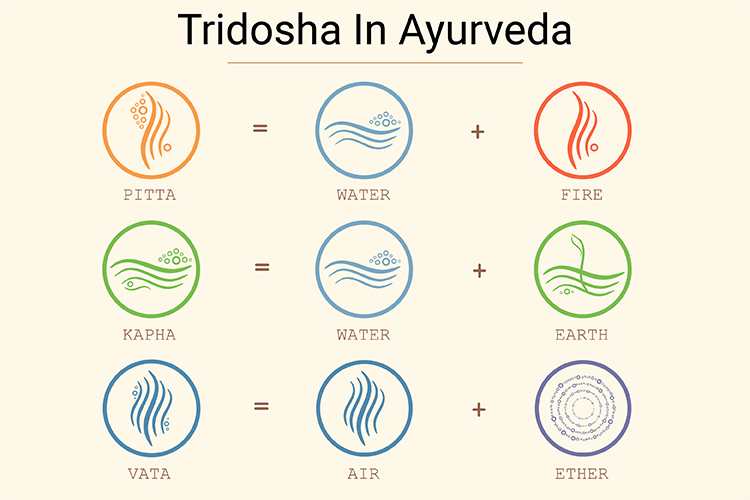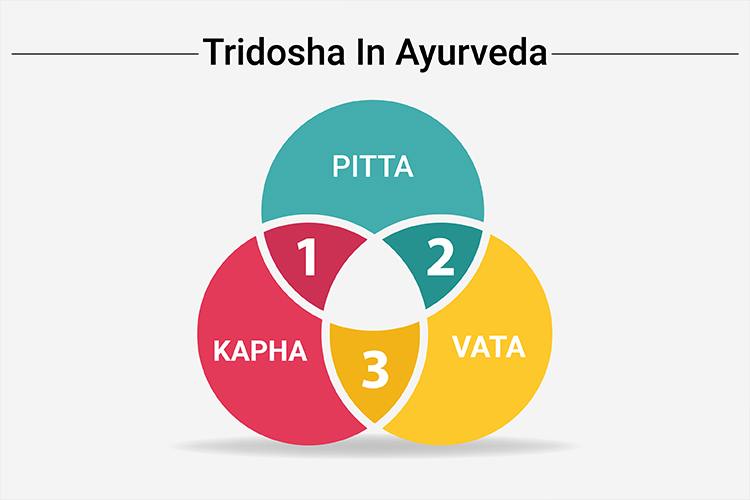Tridosha In Ayurveda
Ayurveda is considered as the world’s oldest healing science. Ayurveda is a sanskrit word that means the science of life. It is a science that focuses on prevention more than cure and is centered around healing and addressing body, mind and soul combinely.
Ayurveda was invented in India more than 5000 years from now. It was actively practiced even before modern science originated, and was taught many years ago by the learned masters to their students.

Table of Content
Ayurveda is also known as the mother of all healing. Ayurvedic knowledge originated in India more than 5,000 years ago and is often called the “Mother of All Healing.”
With the help of Ayurveda, one can create a balance of body and mind.
The fundamentals of Ayurveda are based on forces also known as doshas.
It focuses on three doshas namely Vata, Pitta, and Kapha, which are also known as tridosha. The adoption of the dosha related practices leads to holistic well-being.
Doshas are constituted as the outset of any treatment. Doshas are associated with a person right from their birth and remain unchanged throughout life.

3 Doshas: Vata Pitta Kapha
The 3 primary doshas are named Vata, Pitta, and Kapha. These energy forces are related to the primary functioning of our body.
They are vital for fluids and nutrients flowing, enabling the basic functionality and also lubricating the joints and bones.
Each person has all the three doshas which are Vata, Pitta, and Kapha. However, one of the doshas always remains prominent.
Vata represents movement; Pitta is digestion or metabolism and Kapha is responsible for lubrication.
Know Which Dosha Are You: Vata dosha
Vata is the subtle energy associated with movement.
Vata dosha is made of space and air. This energy form is responsible for breathing, and muscle movement. It controls all the movements of the cell membrane as well.
Individuals who are of Vata body type are creative and brim with ideas. However, they have a very short attention span and can get distracted very easily. They are usually very thin and mostly have cold hands and feet. When Vatta is in balance, it promotes creativity. When imbalanced it creates fear and anxiety.
Vata individuals should take extra care during the time of autumn and early winter. During this time, diet should be paid attention to, as it is important to maintain a routine for these individuals to effectively delegate the moving energy.
On the brighter side, the person predominantly of Vata energy type is intelligent, creative, and flexible.
They learn fast and forget equally faster. The same applies to physical movements, they can run, walk, fast but get tired soon. Vata individuals are less confident, bold, and patient. The imbalance makes them nervous, and anxious too. They do not plan things well. They are not good planners and as a consequence may suffer economic hardship.
Vatta dosha people often like sharp and astringent food like vegetables, raw fruits, and salads.
The places where the Vata resides are the brain, ears, joints, and colon. They are more prone to air-born diseases. Other common Vata disorders include dry skin, hair, flatulence, mental confusion. They have a hard time maintaining a routine. However, it is a prerequisite to lower and control this dosha. People should leave their night-outs and try going to bed by 10 PM as they need more rest than the other types. Practices like steam bath, coconut oil massage before the shower are quite helpful for these masses.
Know Which Dosha Are You: Pitta Dosha
Pitta body types possess the qualities of fire. They can be sharp, agitated, and perceived as the same LEO zodiac sign personalities. Normally, individuals with Pitta are warm-bodied and have exuberating ideas and possess intelligence.
No wonder, Pitta dosha is a combination of intelligence, courage, sharpness, flexible joints, symmetry in hips to shoulder. If you have a pitta body type, you will be happy to find that such people usually have a strong metabolism, good digestion, and appetite, which means they can savor on delicacies. No doubt, they love spicy food!
Moreover, the tastes within them are balanced within sharp, sweet, and bitter flavors. They can’t work or exert for longer hours in the sun. Freckles, premature greying, redness on the skin is found in Pitta individuals. On the flip side, when pitta within the body goes out of balance, the person becomes short-tempered and agitated.
As mentioned earlier, pitta types are intelligent and comprehensive in their approach. They seek to be leaders, planners and inclined towards materialistic affluence.
Pitta people get infected by diseases that involve fire properties such as fever, inflammatory sickness, etc. They need to minimize oily food as that could aggravate the pitta in their body. Summer is a season of heat and pitta and hence these individual are more agitated in the summer and are calmer during the winters. In summer, being short-tempered with Pitta individuals is common along with prickly heat and sunburn.
To maintain health, Yoga is recommended for Pitta individuals. The yoga poses recommended are Low Lunge, Savasana, Fish Pose, Shoulder stand, Variations, Locust, Janu Sirsasana, Pigeon Prep, Seated Twist, Chair Pose, Side Plank, Bridge Pose, 3 Part Breath, Nadi Shodhana, cool breath. These few yoga poses can help Pitta ones to maintain their dosha balance and prevent any health conditions.
Know Which Dosha Are You: Kapha Dosha
This dosha type has strength, endurance, and stamina. Blessed with elegance, and panache, they have heavy personalities. On the negative end, although they are overweight, they neglect exercise. Kapha body types put on weight quickly, and have both slow digestion and metabolism. They may sleep for longer hours, and may still wake up feeling tired and lethargic. Minimum sleep for these individuals should be 7 hours and they should try to go to bed early.
The taste buds preferred by these dosha individuals are sweet, rich, salt flavored food. Their energy constraint is balanced with a sharp, pungent and bitter flavor. People love being around Kapha individuals as they are very calm, and forgiving. They are not at all competitive, as they don’t have the enthusiasm to do anything.
They are slow learners, however, do not forget quickly as they are blessed with an excellent memory.
If Kapha is out of balance, they feel possessive, jealous and develop strong attachments. They are likely to have water diseases and are often inclined to be obese, have diabetes, headaches, and water retention. Water retention is a common and major problem for Kapha individuals and that gets aggravated during a full moon because of water retention properties.
Tridosha Balance
The balance of Tridosha is found very rarely. Tridosha is formed when people have the best of Vatta, Pitta, and Kapha. The doshas are maintained by sustaining a good lifestyle. These individuals are free of diseases and considered healthy.
Tridosha Imbalance
se people may find it easy to stay healthy. They may suffer from various ailments and may need to follow a strict diet to maintain the imbalance.
Tridosha Sites In The Body
Kapha dominates the chest, Pitta around the navel, and Vata below the navel.
Kapha dosha:- Chest, stomach, heart.
Pitta dosha:- Pancreas, digestive glands
Vata dosha:- Uterus, bladder
5 Types of Vata Dosha
Prana Vata
Udana Vata
Samana Vata
Apana Vata
Vyana Vata
5 Types of Pitta Dosha
Pachaka Pitta
Ranjaka Pitta
Alochaka Pitta
Sadhaka Pitta
Bharajaka Pitta
5 Types of Kapha Dosha
Kledaka Kapha
Avalambhaka Kapha
Tarpaka Kapha
Bodhaka Kapha
Shleshaka Kapha
Combination of Ayurveda Dosha Types
There are 7 combinations that are predominantly found when either one of the doshas are dominant. The combination is a well balanced Vata-Pitta-Kapha (Tri-Dosha), Vata-Pitta, Pitta-Vata, Vata-Kapha, Kapha-Vata, Pitta-Kapha, Kapha-Pitta.
Common Lifestyle Changes Suggested to Balance Doshas are:
- Use Oil as per your dosha type
- Try to eat early and eat healthily
- Try to maintain a sleep pattern and sleep hours should be as dosha type
- Eat freshly cooked food and keep yourself hydrated.
- Exercise regularly and meditate as well.
Gunas of Astrology and Doshas of Ayurveda
Just as there are Gunas in Vedic Astrology, the Doshas in Ayurveda have an astrological influence too. Each zodiac sign and planets have their significant dominant Dosha:
Zodiac Signs for
- Pitta: Aries, Leo, and Sagittarius
- Vata: Taurus, Virgo, and Capricorn
- Kapha: Pisces, Scorpio, and Cancer
Planets For Doshas
- Pitta: Mars, Sun, and Ketu
- Vata: Rahu, Shani, Saturn
- Kapha: Moon, Venus, Jupiter
- Tridhaatu Planet: Mercury
- Tridhaatu Signs: Gemini, Libra, and Aquarius
Conclusion
The cause of disease in Ayurveda is viewed as a lack of proper cellular function due to an excess or deficiency of Vata, Pitta or Kapha. Disease can also be caused by the presence of toxins. Hence, the treatments of Ayurveda focus on removing the imbalance of the doshas.
In Ayurveda, body, mind and consciousness work together in maintaining balance. They are simply viewed as different facets of one’s being.
In the physical body, VATA is the subtle energy of movement, PITTA the energy of digestion and metabolism, and KAPHA the energy that forms the body structure.







